
Sometimes a project can come at you from out of nowhere. On this particular occasion, I was sitting at home with a little bit of hobby time on my hands, at something of a loss as to what direction to go in next. I was loathe to start anything momentous, knowing full well that the Adeptus Sororitas release was scheduled to come and derail everything come mid-November. I had just finished with a small expansion project for my Orc Blood Bowl team and I was already done with the fun part of my Mounted Azog project (i.e. the one that was actually mounted). Finding it hard to get excited about painting the exact same miniature again immediately (sans the Warg), I considered my backlog: I had a foot and mounted Sharku mini to paint for my Isenguard Scout Expedition army1, some bits and pieces for my Reikland Reavers Blood Bowl team, ever more Space Wolves… I even entertained the prospect of painting a single miniature from Blackstone Fortress without committing to the whole thing at once2. In the end, I settled on the unglamorous – but very practical – process of painting up a small batch of Grey Slayers for my Heresy-era Space Wolves. Not the most exciting project to work on (having already finished so very many already), but the models in question – more combat shields, a power fist, and some heavy chainswords3 – were all things I wanted to have more of for gaming.
That was.. the plan, anyway. About halfway into the painting process of my Grey Slayer reinforcements, I found myself getting distracted. To be more specific, I had started assembling a sprue of Plaguebearers that have sat in a Jiffy bag, sandwiched between between old mail in my living room for the past year or so. These were models that I bought long ago when I thought I might need them for my summoning pool in Age of Sigmar4. I couldn’t tell you why I was assembling these; I had plenty of other, arguably more useful projects to be getting on with – but after so much layering and edge highlighting lately the thought of blasting through some models with a more wash-centric approach felt… cathartic.
And oooooh boy, was it ever cathartic. While those 10 Space Marines had been taking weeks to assemble, basecoat and highlight (and at the point I typed this sentence, there was another 2 yet to finish), the Plaguebearers were done in a snap. All-in-all, the whole process took me two evenings, start-to-finish. On the first, I’d assembled the 10, then taken them outside to prime with Krylon Camoflague Khaki followed by a zenithal of Hycote White Primer. On the second I got down to painting.
The process is simple – one I devised over two years ago, but remember vividly. Before anything, the models are tinted all over with a coat of Vallejo Yellow Ink. After the last model has been inked, the whole batch get a wash of Athonian Camoshade. Once that dries, they’re given another wash of Reikland Fleshshade. This creates the base tone for the miniatures – a kinda olive, kinda rotten fleshy looking colour that lives somewhere between realistic and cartoonish. Every so often, I’ll mix things up and use Biel Tan Green instead of Athonian Camoshade, or mix some Waywatcher Green into a wash coat just so not every miniature has the exact same skintone. Once the flesh washes have all dried, I pick out the details, one feature at a time.
First up, I deal with the swords and banner poles. One of the quickest steps in the whole process – I basecoat them Vallejo Game Color Filthy Brown, then wash evenly with Agrax Earthshade. When this has dried, I apply a second coat of Agrax Earthshade to any areas that don’t look like they’ve been shaded enough. For the metallics on the icon, I basecoated this in VG Brassy Brass and washed with Reikland Fleshshade. I layered this a little with Brassy Brass again before painting a little Nihilakh Oxide into the recesses, then finished with a hihlight of Army Painter Shining Silver on the raised edges.
Next was the claws, spines and horns. These are all basecoated with Vallejo Heavy Purple. Rather than spending loads of time wet blending every horn, I kind of go for a layered approach and add a little more white to my purple for each successive layer. I add about 3-4 layers over the basecoat, getting increasingly narrower in the case of spines or more concentrated towards the tip in the case of horns. Either way, I aim for to bring the colour a little brighter and desaturated than I’d like, then finish with a slightly thinned wash of Army Painter Purple – towards the recesses for the spines, and pulling downwards from the tip to the base in the case of the horns.
Now onto the exposed muscle, mouth and intestines. I basecoat these in a 70/30 mixture of Vallejo Game Squid Pink and VG Warlord Purple mixed in. This is followed up by a kind of sloppy layer of Squid Pink, over any raised and flat areas, leaving a little more of the recesses than you normally would with a layer. This is followed by a wash of Reikland Fleshshade to help blend it together and make the bright pink flesh look a little more believably fleshy. Finally, I quickly pick out the most exposed areas with Squid Pink mixed with a tiny little bit of White to brighten it up. At this point, I usually get the face out of the way. The eyes are painted VG Filthy Brown and the teeth given a couple thin coats of Elfic Flesh. Both eyes and teeth are washed with Seraphim Sepia before getting layered in their original colours, missing out the recesses. As a final touch, I either dot or paint a slit pupil on the eyes.
That leaves the final touch that, in my opinion, really makes these guys pop en masse – the pustules. Some people just like to highlight theirs, but I like to use them as an excuse to get a little more colour onto the model. My process for these is picking out every single pustule in Vallejo Heavy Red, followed by sucessively smaller ‘dot’ layers of VG Orange Fire and VG Filthy Brown. On the larger pustules, I might follow this with a dot of 50:50 Filthy Brown and Elfic Flesh just to add a little more definition. The layers of red-orange-yellow give them a hot and inflamed look as well as adding a nice contrasting orange to the largely green miniature (with cold purple acccents). You also don’t need to be too precious about accuracy when putting on the initial red layer as this just looks like the skin is irritated around the base of the pustule.
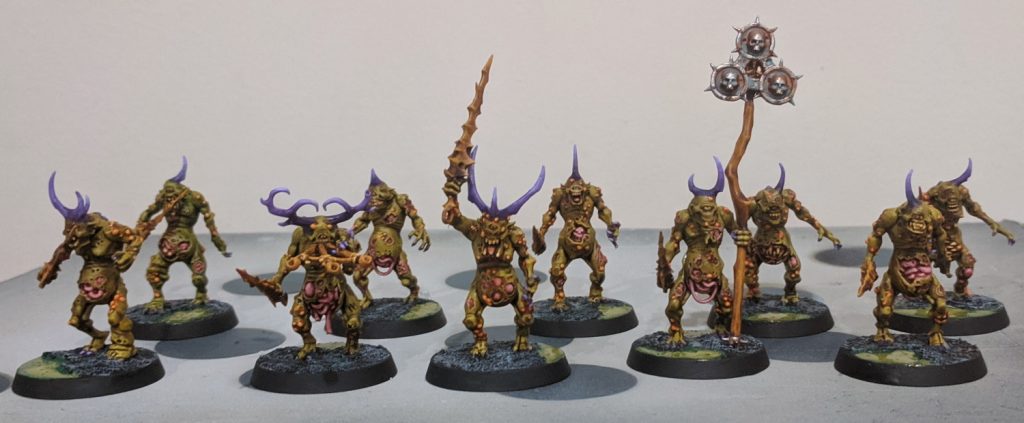
And that’s.. it really. The process of painting Daemons – particularly Bloodletters and Plaguebearers – can be extremely quick and painless and these guys are absolutely no different. After struggling with motivation to slog through edge highlighting 10 power armoured Space Marines all month, this process was extremely gratifying to revisit.
In fact, maybe a little too gratifying. Over the next couple of days, I started to revisit the Daemons of the Ruinstorm army list from The Horus Heresy Book VIII: Malevolance. One thing led to another, and soon I found myself planning out what additions I might need to make to run a 1500pts Daemons army for Warhammer 40,0005 and a 3000pts Daemons of the Ruinstorm list for The Horus Heresy.
In each case, the answer was not as much as you might think.
My first priority was the Daemons of the Ruinstorm army list. When Malevolence finally released (to the relief of many) with the Daemons army list, I honestly didn’t think too much of it. I’ve always sort of preferred my my mainline GW games – Warhammer Age of Sigmar and Warhammer 40,000 – to be separate in terms of tone and content. A lot of that dates back to Age of Sigmar being my first game since returning to the hobby, and since there was no longer a major distinction between playstyles (both being round-based skirmish games as opposed to one being a ranks and flanks style game) wanting my first foray back into Warhammer 40,000 to feel distinct and futuristic (guns, basically. I wanted to paint dudes with guns). However, I found that changing more and more as I made my way through the Black Library’s Horus Heresy book series (mostly on audiobook format while painting) and enjoyed the increasing presence of Chaos, the Warp and Daemons into the narrative. So, after painting these 10 Plaguebearers, I thought that maybe it wouldn’t hurt to have a look at the army list.
I’m incredibly glad I did, because it’s the Daemons of the Ruinstorm army list is a thing of beauty. Instead of following the pattern in the Warhammer 40,000 Codex: Daemons books where every Games Workshop Daemon miniature in production gets a datasheet, instead the Horus Heresy list goes for a looser approach – a nice assortment of generic roles and categories (such as Lesser Daemons, Daemon Cavalry, Daemon Swarms or Daemon Brutes) as well as a limited number of slots in which to customise them from a list of various flavoursome upgrades. On top of that, there’s also 6 different army wide special rules you can assign (amounting to but never explicitly stating Nurgle, Slaanesh, Khorne, Tzeentch, Undivided and ANTI-DAEMON) should you wish to specialise even further – giving unique win conditions and bonuses at the cost of unique weaknesses and restrictions. It’s honestly the most fun I’ve had in figuring out an army list in forever and really captures the same excitement of tooling up and customising your own Daemon Prince back in the 3.5th Edition Chaos Space Marines codex.
After much humming and hawing, I decided the best use of the miniatures I already owned would be to use my Beasts of Nurgle and Plague Drones as Daemon Brutes (the latter with the ‘Wings’ upgrade), my Plaguebearers as Lesser Daemons, Nurglings as Daemon Swarms, Flying Daemon Princes as Daemon Shrikes and my ForgeWorld Great Unclean One as a Greater Daemon or even an Arch Daemon (the ForgeWorld Bloodthirster is watermarked on the backdrop of the Arch Daemon profile page after all). I took stock of what miniatures I owned – 3 Beasts (4 if you include my old Great Unclean One as a ‘Unit Champion’), 6 Plague Drones, 40 Plaguebearers, 9 Nurgling stands, a Herald of Nurgle, a flying Daemon Prince and my Great Unclean One. Next up was to build an army list and figure out exactly what I’d need. Eventually, I settled on the following:
++ Daemons of the Ruinstorm [3,000pts] ++
Aetheric Dominion: Creeping Scourge
+ HQ +
Cor’bax Utterblight Unbound, Daemon Lord Of The Ruinstorm
Ruinstorm Greater Daemon
2x Lord of Sorcery, Flensing Talons, Horned Crown, Warp-scaled Hide
Ruinstorm Daemon Chosen
2x Lord of Sorcery, Crushing Claws, Warp-scaled Hide
+ Elites +
6x Ruinstorm Daemon Brutes
Crushing Claws, Daemonic Wings
3x Ruinstorm Daemon Brutes
Crushing Claws, Warp-scaled Hide
+ Troops +
14x Ruinstorm Lesser Daemons
Miasma of Rot, Warp-scaled Hide
14x Ruinstorm Lesser Daemons
Miasma of Rot, Warp-scaled Hide
14x Ruinstorm Lesser Daemons
Miasma of Rot, Warp-scaled Hide
14x Ruinstorm Lesser Daemons
Miasma of Rot, Warp-scaled Hide
7x Ruinstorm Daemon Swarms
Warp-scaled Hide
+ Fast Attack +
Ruinstorm Daemon Shrike
Flensing Talons, Warp-scaled Hide
Ruinstorm Daemon Shrike
Flensing Talons, Corrosive Vomit
Having (at the time of typing this), never taken this army out for a spin, I’m not rightly sure how it would do against the Legions, let alone against Militia, Solar Auxillia, Mechanicum or Talons (although I can imagine that one), but it feels pretty dangerous on paper and – more importantly – really feels like an army. There’s a good bit of everything, from huge monstrosities in the form of Cor’Bax and the Greater Daemon, as well as a ton of foot soldiers, some swarms and some mobile and dangerous daemon princes. I’ve gone back and forth a lot of whether or not to bring an Arch Daemon into the list, but at 750 points for the loadout I’d like, he just works out at way too many points for a 3000 point game. The jury is still out on whether he’d actually be effective or not, but in my experience having so many eggs in a single model basket at 3000 points doesn’t tend to lead to very fun or interactive games. And besides, using my GUO as a Greater Daemon instead gives me more points to field so many more awesome miniatures, and that’s sort of the real aim here anyway, right?
That was Heresy taken care of. Before I got started adding items to my cart and pencilling in a schedule for impending hobby, I still had to write a list for Warhammer 40,000.
After a little bit of tinking, here’s what I came up with:
++ Chaos Daemons [1500pts] ++
Allegiance: Nurgle
Detachment 1 – Battalion
+ HQ +
Daemon Prince of Nurgle
Hellforged Sword, Malefic Talon, Warp Bolter, Wings
Daemon Prince of Nurgle
2x Malefic Talon, Warp Bolter, Wings
+ Troops +
30x Plaguebearers
Daemonic Icon, Instrument of Chaos
30x Plaguebearers
Daemonic Icon, Instrument of Chaos
10x Plaguebearers
Daemonic Icon
+ Fast Attack +
6x Plague Drones
Daemonic Icon, Instrument of Chaos
Detachment 2 – Battalion
+ HQ +
Poxbringer
Poxbringer
+ Troops +
3x Nurglings
3x Nurglings
3x Nurglings
Alright, so I know what I’m doing with this army list a little more. Three units of Nurglings setting up 9 inches outside my opponents deployment help really set me up for getting the pair of flying daemon princes up in my opponents face, whilst the big blobs of Plaguebearers with Objective Secured, Cloud of Flies, 5+ invulnerable and 5++ Disgustingly Resilient saves will be great for holding down objectives. Meanwhile, the Plague Drones can be surprisingly fast with a good roll for Advance, and are great for tying down enemies to pile the Daemon Princes into. As a cherry on top, Poxbringers are remarkably cheap and surprisingly tough-to-remove Psykers – making them an incredibly useful HQ choice for spamming CP’s. While I doubt this list is going to make anyone cringe in the competitive scene (except, maybe out of embarrassment), it’s a massive departure from my Space Wolves (albeit still a combat oriented one) and should at least make my regular opponents come out of autopilot a bit.
Looking at both lists, the gaps in my collection appeared to be:
- Cor’Bax Utterblight, Daemon Prince of the Ruinstorm
- A second Winged Daemon Prince/Shrike
- Yet more Plaguebearers. About 20 more (giving me 2x units of 30 and 1x unit of 10, all with full command, or a 3x units of 20 without) all told!
Pretty doable, right? After quick trip to ForgeWorld and eBay, my latest excuse to put off painting Blackstone Fortress was in full-swing!
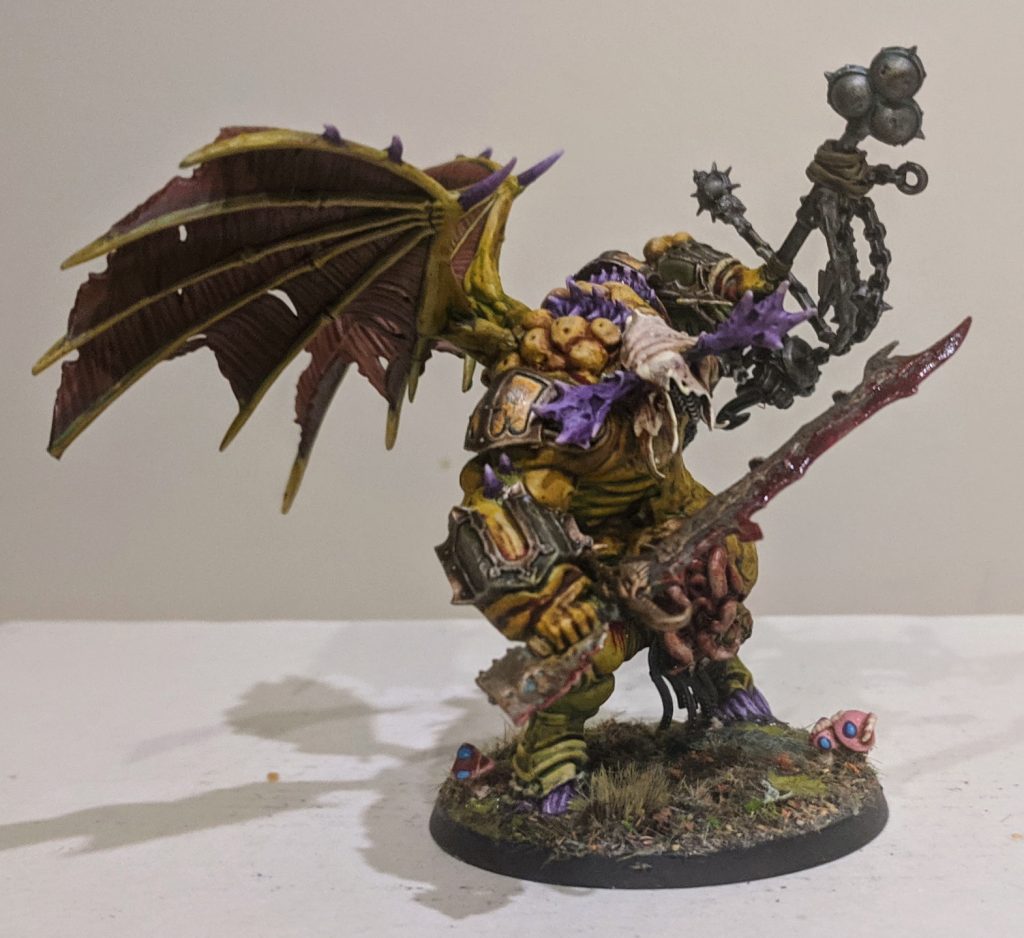
The first thing that I got cracking on was the Plaguebearers – I was already on a bit of a roll with them, and I figured it was best to get the ‘boring’ stuff out of the way (having now already done 50 of them). These were, predictably, the exact same to paint as the 10 I described previously, so I won’t bother going through my process again. The main differentiating factor was that it’s been a good wee while since I last batch painted 20 models in a one go though. This was.. efficient, but a lot less enjoyable than the initial 10. There’s just something really soul crushing about repeating the same steps across 20 miniatures (which can take anywhere between 10 and 20 minutes depending on what the step is) only to look at your great batch of Plaguebearers and feel like you’re barely any further forward.
Ah well. I did manage to knock them out in two evenings after work, which probably saved me a further evening had I painted them in two batches of 10 – and even then, after I finished the first batch, I’d still have the demoralizing hit of another 10 to get through from scratch anyway.
Around the time that I’d finished these Plaguebearers, the rest of my goodies hadn’t quite arrived yet. Not content to sit around idle, I decided that – given all the extra bitz leftover from recent addition of 30 Plaguebearers – I’d use up some of my excess Nurgling models and build some bases of Nurgling Swarms.
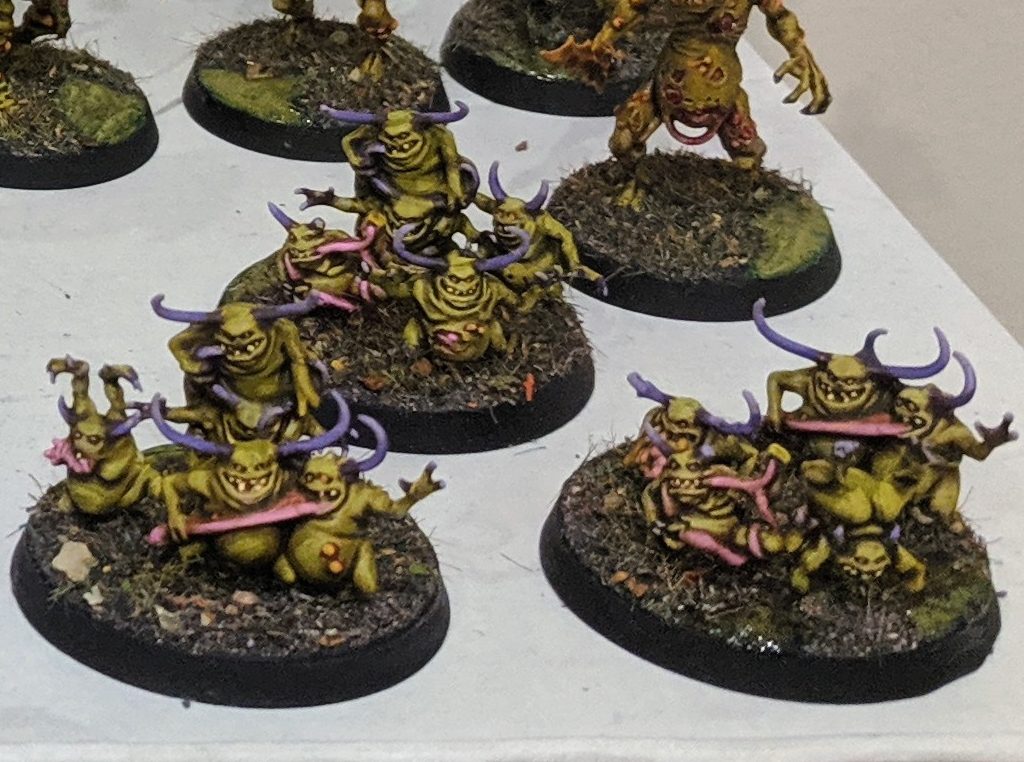
This turned out be be pretty fun diversion, in the end. I had enough of the “big Nurglings” from the actual Nurglings kit that I could put at least one or two ‘pairs’ of them on each of the bases, and filled up the rest of the space with the little guys from the Plaguebearer sprue (just not the ones tugging at intestines). I have to say, I actually.. really rather prefer the look of these over the standard Nurgling-pyramids you get out of the basic box set – and they’re a LOT more fun to paint when you’re not trying to navigate your brush around a mish mash of contorted little dudes.
The addition of these 3 bases gives me a total of 12 bases of Nurglings in total (9 pyramids, 3 loose), and I’m honestly considering picking up another box of Nurglings and making 6 more – using half the amount of pyramid-Nurglings and using the rest of the space to put little loose dudes. That would hopefully ‘blend’ the 3 loose ones in better with the other 9, at least. Plans for another time!
By the time I’d finished these little snots, the crown jewel had finally arrived: Cor’Bax Utterblight, Daemon Lord of the Ruinstorm.
To say I was excited to paint this miniature was the understatement of the century. Since I discovered this miniature existed – well before the plastic Great Unclean One was ever released – I have been seriously lusting after one. Unfortunately, he’s just a little too dinky to be used in Age of Sigmar as a Great Unclean One, so I’d never really managed to justify picking one up. With the advent of the Daemons of the Ruinstorm list, it was finally happening.
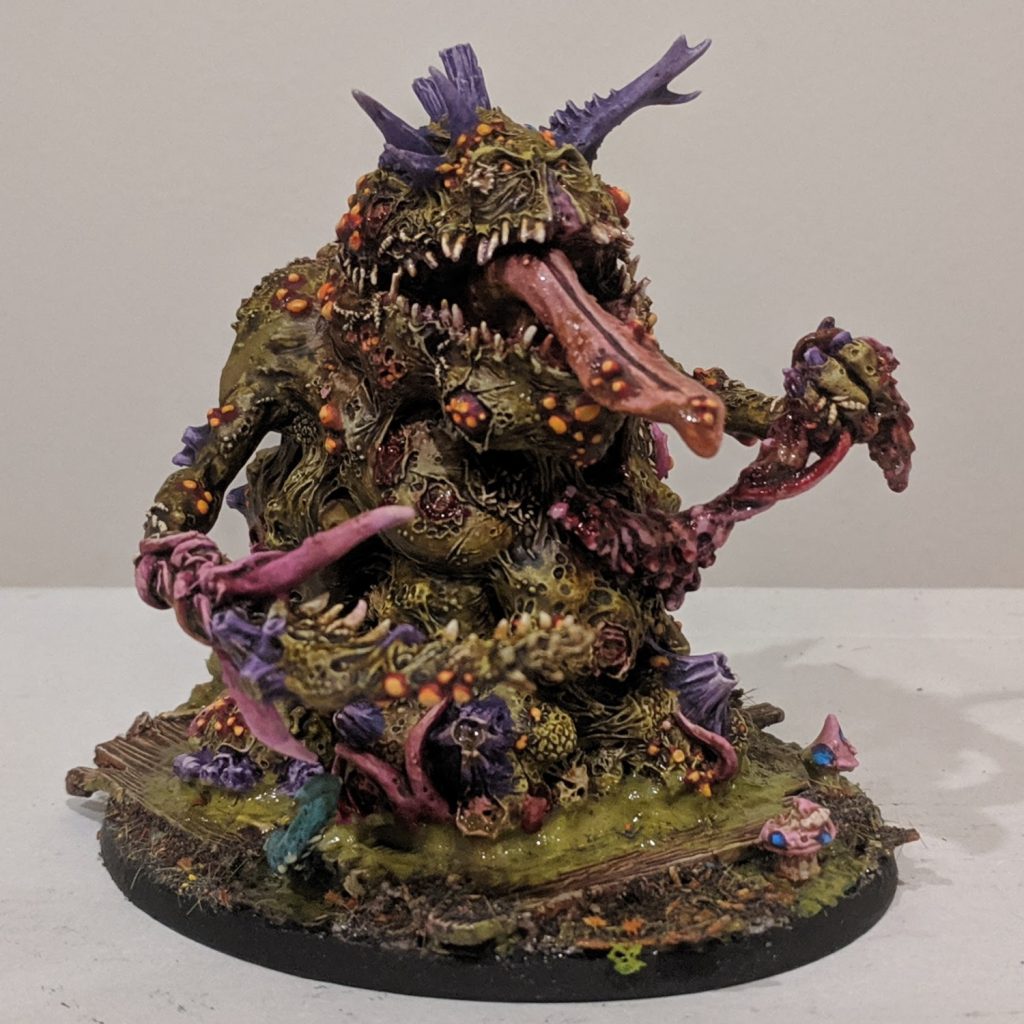
In spite of all my excitement, I don’t really have all that much to talk about with regards to his paint job that I haven’t said already. The flesh, horns and pustules were all just sort of painted the same way as I do my Plaguebearers – albeit with a little more care in the blending. The key changes with the flesh is that I will often concentrate my use of Reikland Fleshshade in any arm or leg pits, the underside of chins and any other similar folds in flesh just to make them look a little bit inflamed.
The mushroom caps growing out of his back I painted in the exact same manner as I do the mushrooms on my bigger models’ bases – basecoat of VG Elfic Flesh, with the upper side of the cap painted VG Squid Pink. The whole thing – especially the underside – is washed in Reikland Fleshshade. Then the spots are done with big blobs of VG Heavy Purple with a slightly smaller blob of Magic Blue on top. As these mushrooms were a little bigger than usual, many of them received a final blob or edge highlight of VG Electric Blue just to really make them pop. I think they work really well on the miniature as they do on the base – the pink and off/white are both colours present on his teeth, gums, tongue and intestines, with the blue providing a nice cold spot colour to contrast against the warm tones of the pustules.
For his base, I really wanted to evoke the same sort of style as my Great Unclean One, but a little less over the top – as he himself is a little smaller. To this end, I used the same Goblin Town walkways as a bit of broken or loose floatsam or boardwalk and based around it with the same heavily-textured ‘bog’ style that the rest of the army is based on.

I should probably go into the standard basing a little, as I missed it out on the Plaguebearers. Originally, my Maggotkin of Nurgle army was based on a fairly standard style of basing – grey texture paint with some puddles of Nurgle’s Rot and a little bit of flock here and there. The larger models were given Spellcrow Mushrooms for a little further interest. I had originally done these this way to match my Khorne Bloodbound army – which were painted, as was the tradition, to look like they came from Aqshy, the realm of fire. My idea here was that I would keep the basis of my Chaos Grand Alliance bases the exact same while changing some loose ‘features’ and – should I ever collect all four Chaos Gods, I could lead them into battle as one momentous horde. This was.. nearsighted, however. Eventually, my Khorne Bloodbound were sold (as I lacked any real emotional connection to them) and my Nurgle were left with.. kinda uninspired bases. A few months back, I decided to change that, and the easiest way I could think that would still look good would be to glue down an interesting blend of flock over the top, leaving the pools of Nurgles rot and building up the height with water texture effects.
The blend was a Forest Scatter, I think, from Serious Play (who sell a lot of hobby materials and scatter blends on eBay), mixed in with a number of little additions that I felt added to the ‘bog’ feel – little dead leaves from Green Stuff world, a Gale Force 9 autumnal flock blend which kind of (inadvertently) gives the impression of spores and other contaminants, as well as a bunch of Gale Force 9 Winter Grass. In the end, I think the decision paid off – it took a while to get it all glued on (and water texture spread on when dry) for the 80 odd miniatures in my Maggotkin of Nurgle army, but I think it’s made them several orders of magnitude more interesting to look at – which is great for motivation going forward in this ‘pivot project’. I’m still at least a little considering painting the rims a nice light chocolate brown (such as on my Blood Bowl minis), but that’s a project for another day.
The final pièce de résistance for the project was a second Flying Daemon Prince in 40K terms, or Shrike if we’re talking Heresy.
Continuing my trend of using ForgeWorld miniatures6 for my big beasties wherever possible, I decided to once again forgo the kind of cartoonish Games Workshop Daemon Prince kits in favour of something a little darker – the ForgeWorld Daemon Prince of Nurgle kit. This guy, like all the others, is brilliant – grim, hideous, and dripping with little details like pustules and larvae. His rictus half-grin and drooping tongue hanging out a hole in his cheek are absolutely chilling and capture the same sort of grim and threatening vibes that I was going for with my first Daemon Prince.
The only problem was that he lacked wings. This was a problem for Warhammer 40,000 – completely unusable as a Shrike for the Horus Heresy. Time to get creative.
Creative, but not wholly original. I actually stole the concept from a fellow Heresy enthusiast, who shared a conversion on a Heresy WhatsApp chat room that we’re both in. His conversion was a combination of the Games Workshop Finecast Nurgle Daemon Prince and the turbines from a Forgeworld Greater Blight Drone. I really loved the concept of giving a more 40K-looking Daemon Prince a kind of fleshmetal jump pack rather than the kind of fleshy-wings approach, and I started looking into similar ideas – which is how I stumbled on the ForgeWorld Daemon Prince of Nurgle. I really didn’t want to spend £45 odd on a jump pack though, so I started looking into other alternatives, which I found in the form of a Foetid-Bloat Drone. Unable to source the specific bitz alone, I managed to find a snap-fit one from the Dark Imperium box set off of eBay for around a tenner – much more reasonable, I thought.
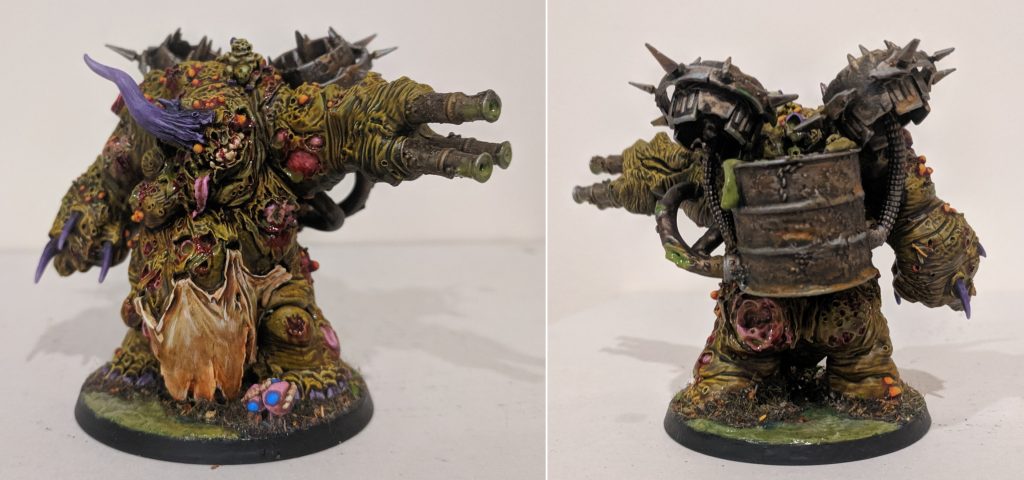
The conversion required a decent amount of hacking away at resin and filling with green stuff. First of all, one of the little Nurglings on his left shoulder was just a little too inconveniently close to where I wanted my turbine to come out of, so I had to take apart the whole shoulder to get him off. Once I had the space, it was fairly trivial to pin the turbines to his shoulders and fill in the gaps with green stuff – Nurgle models are pretty forgiving that way. Unfortunately, the model still looked a little.. off. The jump pack just didn’t feel like it was seamlessly blending with the model and looked too.. tacked on. I thought about it for a while until it became apparent why – the reason for the drum of filth on the Daemon Prince’s back was that it was like an ammo drum for his horrendous triple barrelled fleshmetal flame weapon. If I wanted the jump pack to fit aesthetically, it would need to be ‘powered’ the same way.
Enter my Green Stuff World Roll Maker Set. This is a neat little tool that I won for getting ‘Best Painted Team’ at an Age of Sigmar doubles event with my friend Scott. The idea behind the contraption is you roll a sausage of green stuff between the two textured plates and it produces something that looks like a tentacle or a cable, depending on thickness, technique and plate set up. This was ideal for this situation, and I made two rolls of similar length and girth as the cable connecting the drum of filth to his gun.
The results, I think speak for themselves. I’m immensely impressed with the results that the Roll Maker put out. Stylistically the cabling looks slightly different from the gun, but they match each other well and it makes sense that a ‘power’ cable might look different from a weapon hose. I connected the cables to the base of the drum – onto the same output as the gun for the right side, while the right side got a little covering sculpted for where it met the drum. With that, the conversion finished and the last model in my Daemons was ready for painting.
I have even less to say about the paint job for this miniature than I do Cor’Bax – the same process, just extrapolated up for a big guy. About the only thing that was truly ‘different’ on this model was his little loincloth to protect his modesty – for that, I basecoated Elfic Flesh and successively painted on Fuegan Orange in lines towards the bottom of the cloth to evoke a sense of grime. This was blended afterwards by glazing Seraphim Sepia across the upper portion, and finally edge highlighting and tidying with a few thin layers of Elfic Flesh. The metals were the same ‘rust’ process as ever – AP Plate Mail with a few shades of Agrax Earthshade to grime it back up. On the otherwise smooth jump pack turbines, I also applied watered down coat of Typhus Corrosion to add a little textuer. Afterwards, I took some watered down VG Fire Orange and pooled some spots of the paint across various pits and recesses to add more of a ‘rusty’ feel. The final step was edge highlighting with AP Shining Silver, and – following the usual steps of Dullcote, apply Nurgle’s Rot/Blood for the Blood God and basing effects – the miniature and my Daemons of the Ruinstorm army was complete.
So, here they are, in all their infernal, pestilent glory.
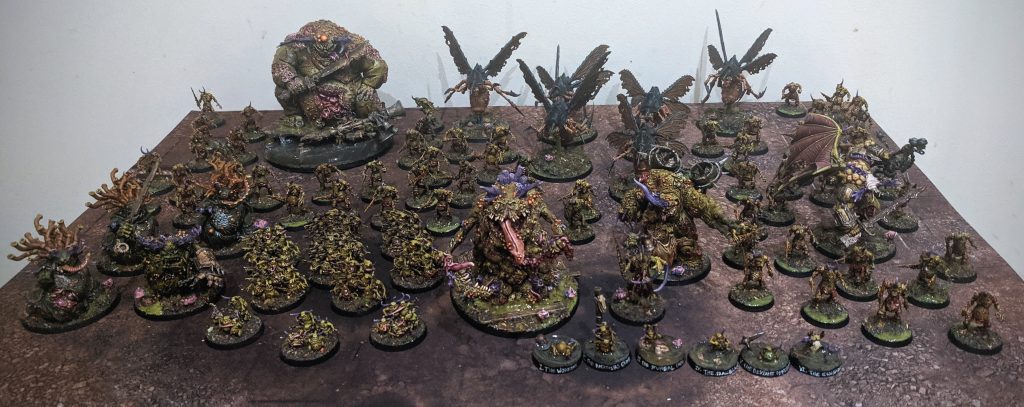
It’s been great fun revisiting this army in an entirely different context. Not only has the journey into the 41st Millenium helped chip away at my pile of shame (albeit by a single box of Plaguebearers), but it’s also helped bring new life to my Maggotkin army (or at least their basing scheme) in the process and allowed me to work on some amazing models that I’ve had my eye on for some time. I’m really looking forward to these guys getting more time on the tabletop again soon!
As ever, thanks for reading, and happy wargaming!
1 Another low-hanging fruit project I’m planning on starting whenever I next really want to put off that Azog’s Legion army and Blackstone Fortress some more (not dissimilar to this one, actually). The idea is that I already have Lurtz, Ugluk and a bunch of Uruk-hai Scouts and Warg Riders painted, so it might be cool to add some more named heroes into the mix and do a full on “Find the Halflings!” themed Scout Expedition army. The plan, for the moment, is 24 Scouts, 8 Warg Riders, Lurtz, Ugluk, Sharku, Mauhur, plus Saruman and Grima up in their ebony tower. 5 models to paint total (7 if you count horses) for an 800 points army? Not bad.
2 HAHAHAHAHAHAHAHAHAHAHAHAHAHAHAHA
3 Ah, heavy chainswords. As garbage on the tabletop as they are absolutely awesome to behold. Practically speaking, they’re considerably less useful to have more of than, say, more combat shields or basically any other weapon upgrade for Grey Slayers. That being said, prior to these reinforcements, I currently owned a whole one Grey Slayer model armed with one of those stupid weapons – and he’d pretty much never see the tabletop because who really wants to roll separately for one S6 AP4 attack (two in the first round) in every round of combat? At least having five in a squad means they’ll be a meaningful (if a bit rubbish) sub-combat. On a side note, that does mean I now have 4 Power Axes, 4 Power Swords, 4 Power Fists and.. 5 Heavy Chainswords total. Can’t win.
4 That sort of dates when I purchased these miniatures – I haven’t really done much hobby at all for Age of Sigmar, let alone my Maggotkin of Nurgle – in about a year.
5 One of my regular Warhammer 40,000 8th Edition opponents has been consistently taking my Space Wolves out to pasture with a Necron Destroyer army – to the point where I’m not entirely sure there’s even a solution to his army to be found in Codex: Space Marines or it’s variants – and certainly not with a combat-oriented Space Wolves army. Looking back, I’ve only had a single game go well against this army in recent memory, and that was a Daemons-heavy Chaos Space Marines army I used a pretty long time ago – mostly due to the combination of reasonably fast moving flying units and a big blob of infantry that negate many of the key advantages of Destroyers. I don’t know whether this army will fare any better than my Space Marines, if I’m honest, but at this point any change is for the better.
6 Seriously, for all that ForgeWorld’s prices are no guarantee of quality in some cases, their work on various Nurgle Daemon characters are essential. I absolutely adore everything they’ve done here – the Great Unclean One, the Daemon Prince, Cor’Bax. It’s all grim, chilling and with a spectacular eye for detail without ever feeling crowded or overwroght. It really captures the tone of despair that Nurgle used to be associated with in Warhammer 40,000 – in a way that Games Workshop can’t help but completely fail at.

Oh wow. This looks amazing!
Have you had a chance, in the meantime, to take this army out for a stroll? I really wonder how it will perform against Legion lists.
Thank you so much!
Sadly, they remain untested in battle for now – I was planning on taking them to an event in November, but due to moving and getting the flu I had to cancel. With any luck, they’ll be there for the next event in May. With any luck, I’ll get a practice game or two in before that though, I’ll keep you posted!